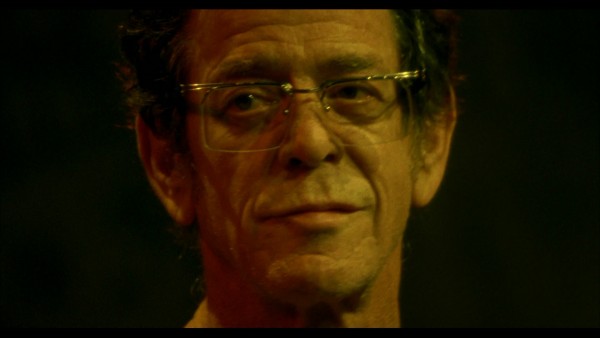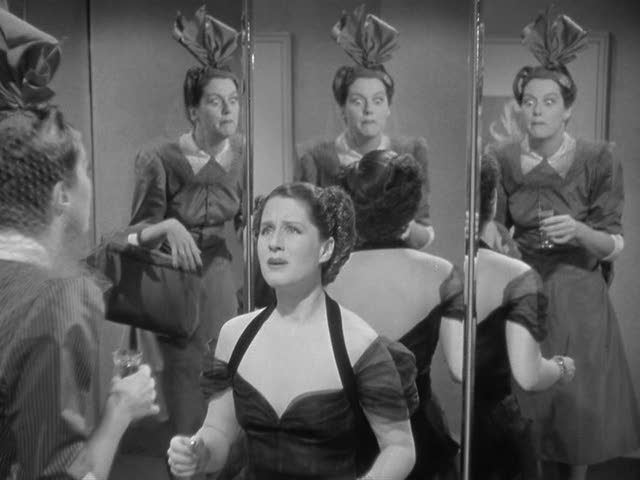
Mrs. Stephen Haines (Norma Shearer) discovers some awful truths in George Cukor’s THE WOMEN
CABARET CINEMA: THE WOMEN (George Cukor, 1939)
Rubin Museum of Art
150 West 17th St. at Seventh Ave.
Friday, November 1, free with $7 bar minimum, 9:30
212-620-5000
www.rmanyc.org
 One of the cattiest movies ever made, The Women is a screwball comedy that has the distinction of not having a single man in it; it was even written by Anita Loos and Jane Murfin, based on Clare Booth’s 1936 Broadway play, and helmed by George Cukor, who is often considered “the women’s director.” Set in Manhattan, the film follows the intrigue and gossip surrounding a group of socialite women who yap yap yap all day long while shopping in ritzy stores, eating in fancy restaurants, and getting their nails done in high-end salons. Their attention is suddenly turned to the sweetly innocent Mary Haines (Norma Shearer) when it is believed that her husband, Stephen, is having an affair with conniving perfume salesperson Crystal Allen (Joan Crawford). Mary’s supposed best friends, Sylvia Fowler (Rosalind Russell), Edith Potter (Phyllis Povah), and Peggy Day (Joan Fontaine), at first keep the story from her, but as the facts continue to pile up, Mary considers heading to Reno to get a quickie divorce, even as her mother (Lucile Watson) tells her to just live with the deception, as most women do. In Reno, Mary stays at a ranch with other wives trying to get out of their marriages, including a boisterous, oft-wed countess (Mary Boland), a tough-talking chorus girl (Paulette Goddard), and a few surprises. As the women discuss life and love, wealth and poverty, heartache and motherhood — Mary is desperate to protect her daughter, also named Mary (Virginia Weidler), from the nasty proceedings — relationships twist and turn, loyalty is questioned, and the possibility of true love is clouded in doubt.
One of the cattiest movies ever made, The Women is a screwball comedy that has the distinction of not having a single man in it; it was even written by Anita Loos and Jane Murfin, based on Clare Booth’s 1936 Broadway play, and helmed by George Cukor, who is often considered “the women’s director.” Set in Manhattan, the film follows the intrigue and gossip surrounding a group of socialite women who yap yap yap all day long while shopping in ritzy stores, eating in fancy restaurants, and getting their nails done in high-end salons. Their attention is suddenly turned to the sweetly innocent Mary Haines (Norma Shearer) when it is believed that her husband, Stephen, is having an affair with conniving perfume salesperson Crystal Allen (Joan Crawford). Mary’s supposed best friends, Sylvia Fowler (Rosalind Russell), Edith Potter (Phyllis Povah), and Peggy Day (Joan Fontaine), at first keep the story from her, but as the facts continue to pile up, Mary considers heading to Reno to get a quickie divorce, even as her mother (Lucile Watson) tells her to just live with the deception, as most women do. In Reno, Mary stays at a ranch with other wives trying to get out of their marriages, including a boisterous, oft-wed countess (Mary Boland), a tough-talking chorus girl (Paulette Goddard), and a few surprises. As the women discuss life and love, wealth and poverty, heartache and motherhood — Mary is desperate to protect her daughter, also named Mary (Virginia Weidler), from the nasty proceedings — relationships twist and turn, loyalty is questioned, and the possibility of true love is clouded in doubt.
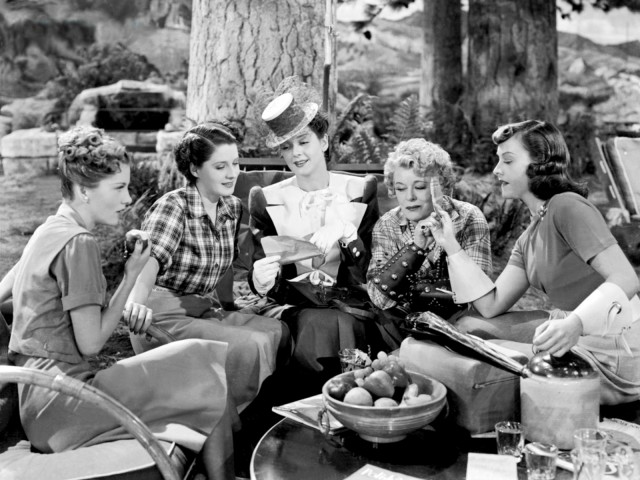
An all-star cast discuss what went wrong with their marriages in THE WOMEN
The Women is a riotous, fast-paced romp that flies by despite clocking in at more than two hours. The opening title sequence sets the stage, with each of the main characters represented by a different animal: deer (Mary), leopard (Crystal), black cat (Sylvia), monkey (the countess), hyena (Miriam), sheep (Peggy), owl (Mary’s mother), cow (Edith), doe (Mary’s daughter), and horse (Lucy). The narrative mixes slapstick humor and tender moments with scenes of backstabbing bravado. Dennie Moore nearly steals the show as fabulously gossipy manicurist Olga, who unwittingly sets the main plot in motion and is responsible for painting many of the characters’ nails in the critical color Jungle Red. (Among the other highlights are an exercise class at the spa and the maid spying on a heated argument between Mary and Stephen.) The cast also features Hedda Hopper as gossip columnist Dolly Dupuyster, Butterfly McQueen as Crystal’s assistant, Lulu, and Marjorie Main as Lucy, who runs the Reno divorce ranch. Although the film was primarily shot in black-and-white, it has an oddball Adrian fashion show in Technicolor that feels out of place, and some of the ideas regarding a woman’s freedom versus her dependence on men don’t quite hold up, but The Women is still one of the greatest Hollywood pictures ever told from the perspective of the fairer sex. Amazingly, Cukor’s film did not receive a single Oscar nomination, having come out the same year as Wuthering Heights, Stagecoach, Mr. Smith Goes to Washington, Gone with the Wind, Ninotchka, Love Affair, Dark Victory, The Wizard of Oz, and Goodbye, Mr. Chips. The Women is screening November 1 as part of the Rubin Museum Cabaret Cinema series “I Don’t Know” — “about what we don’t know, or choose not to know” — and will be introduced by Justin Vivian Bond. The festival continues November 8 with John Kelly introducing Alfred Hitchcock’s Shadow of a Doubt and November 15 with Rachel Dratch introducing Peter Brook’s Lord of the Flies.
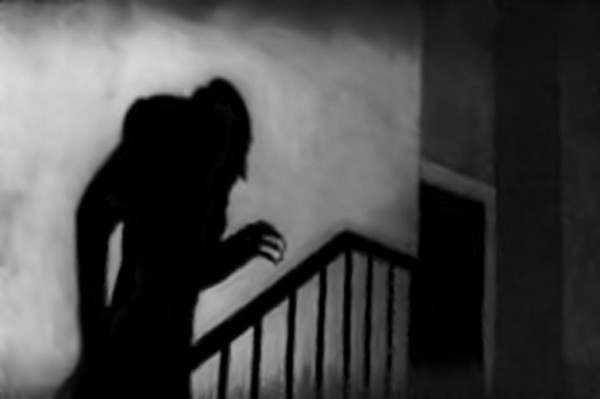
 In F. W. Murnau’s classic horror film, Max Schreck stars as Count Orlok, a creepy, inhuman-looking Transylvanian who is meeting with real estate agent Thomas Hutter (Gustav von Wangenheim) in order to buy a house in Germany. Hutter soon learns that the count has a taste for blood, as well as lust for his wife, Ellen (Greta Schröder), whom he has left behind in Germany. When Count Orlok, a bunch of rats, and a group of coffins filled with Transylvanian earth head out on a ship bound for Wisborg, the race is on to save Ellen, and Germany. Murnau’s Nosferatu is set in an expressionist world of liminal shadows and fear, as he and cinematographers Fritz Arno Wagner and Günther Krampf continually place the menacing Orlok in oddly shaped doorways that help exaggerate his long, spiny fingers and pointed nose and ears. Unable to acquire the rights from Bram Stoker’s estate to adapt the Gothic horror novel Dracula into a film, writer Henrik Galeen (The Golem, The Student of Prague) and director Murnau (Sunrise, The Last Laugh) instead made Nosferatu, paring down the Dracula legend, changing the names of the characters, and tweaking the story in various parts. Upon its 1922 release, they were sued anyway, and all prints were destroyed except for one, ensuring the survival of what became a defining genre classic. In 1979, German auteur Werner Herzog (Woyzeck, Fitzcarraldo) paid tribute to the earlier film with Nosferatu the Vampyre, a near scene-by-scene homage to Murnau’s original but with Stoker’s character names restored, as the book was by then in the public domain. Hans Erdmann’s complete score no longer exists, so numerous musical compositions have accompanied screenings and DVD/VHS releases over the years; at Film Forum, pianist Steve Sterner will offer his take on November 4 at 7:30.
In F. W. Murnau’s classic horror film, Max Schreck stars as Count Orlok, a creepy, inhuman-looking Transylvanian who is meeting with real estate agent Thomas Hutter (Gustav von Wangenheim) in order to buy a house in Germany. Hutter soon learns that the count has a taste for blood, as well as lust for his wife, Ellen (Greta Schröder), whom he has left behind in Germany. When Count Orlok, a bunch of rats, and a group of coffins filled with Transylvanian earth head out on a ship bound for Wisborg, the race is on to save Ellen, and Germany. Murnau’s Nosferatu is set in an expressionist world of liminal shadows and fear, as he and cinematographers Fritz Arno Wagner and Günther Krampf continually place the menacing Orlok in oddly shaped doorways that help exaggerate his long, spiny fingers and pointed nose and ears. Unable to acquire the rights from Bram Stoker’s estate to adapt the Gothic horror novel Dracula into a film, writer Henrik Galeen (The Golem, The Student of Prague) and director Murnau (Sunrise, The Last Laugh) instead made Nosferatu, paring down the Dracula legend, changing the names of the characters, and tweaking the story in various parts. Upon its 1922 release, they were sued anyway, and all prints were destroyed except for one, ensuring the survival of what became a defining genre classic. In 1979, German auteur Werner Herzog (Woyzeck, Fitzcarraldo) paid tribute to the earlier film with Nosferatu the Vampyre, a near scene-by-scene homage to Murnau’s original but with Stoker’s character names restored, as the book was by then in the public domain. Hans Erdmann’s complete score no longer exists, so numerous musical compositions have accompanied screenings and DVD/VHS releases over the years; at Film Forum, pianist Steve Sterner will offer his take on November 4 at 7:30.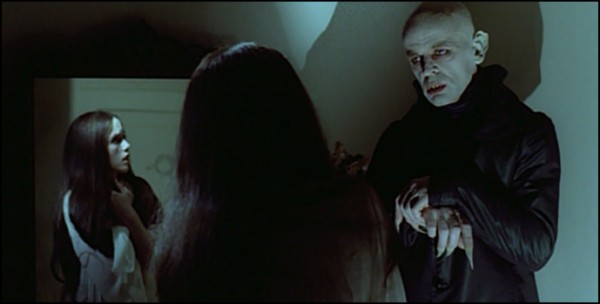
 Nearly sixty years after Murnau battled the Stoker estate, Herzog remade Nosferatu with an all-star cast featuring Bruno Ganz as real estate agent Jonathan Harker, Isabelle Adjani as his wife, Lucy, and Klaus Kinski as Count Dracula. Shot in flat colors by Jörg Schmidt-Reitwein and set to a score by German electronica band Popol Vuh, Herzog’s Nosferatu follows the same path as Murnau’s, as Jonathan Harker travels to Transylvania to have the count sign a contract, discovers that Dracula likes blood and sleeps in a coffin, then tries to save his wife when the count and thousands of (purportedly mistreated) rats sail to Wismar, renewing fears of plague. Kinski plays the count as a sad, lonely figure who no longer belongs in the modern world. He’s desperate for human contact, and his castle has seen much better days. Kinski often seems to be shot in black-and-white, surrounded by color, as if he were from another time, except for his shockingly red lipstick. It’s a virtuoso performance that is significantly more nuanced than Schreck’s, which is a more direct take on the character. Both films are gems; Film Forum is showing a new 35mm print of the rare German-language version of Herzog’s remake through November 7; on November 4 you can see them both, with separate paid admission.
Nearly sixty years after Murnau battled the Stoker estate, Herzog remade Nosferatu with an all-star cast featuring Bruno Ganz as real estate agent Jonathan Harker, Isabelle Adjani as his wife, Lucy, and Klaus Kinski as Count Dracula. Shot in flat colors by Jörg Schmidt-Reitwein and set to a score by German electronica band Popol Vuh, Herzog’s Nosferatu follows the same path as Murnau’s, as Jonathan Harker travels to Transylvania to have the count sign a contract, discovers that Dracula likes blood and sleeps in a coffin, then tries to save his wife when the count and thousands of (purportedly mistreated) rats sail to Wismar, renewing fears of plague. Kinski plays the count as a sad, lonely figure who no longer belongs in the modern world. He’s desperate for human contact, and his castle has seen much better days. Kinski often seems to be shot in black-and-white, surrounded by color, as if he were from another time, except for his shockingly red lipstick. It’s a virtuoso performance that is significantly more nuanced than Schreck’s, which is a more direct take on the character. Both films are gems; Film Forum is showing a new 35mm print of the rare German-language version of Herzog’s remake through November 7; on November 4 you can see them both, with separate paid admission.
 One of the cattiest movies ever made, The Women is a screwball comedy that has the distinction of not having a single man in it; it was even written by Anita Loos and Jane Murfin, based on Clare Booth’s 1936 Broadway play, and helmed by George Cukor, who is often considered “the women’s director.” Set in Manhattan, the film follows the intrigue and gossip surrounding a group of socialite women who yap yap yap all day long while shopping in ritzy stores, eating in fancy restaurants, and getting their nails done in high-end salons. Their attention is suddenly turned to the sweetly innocent Mary Haines (Norma Shearer) when it is believed that her husband, Stephen, is having an affair with conniving perfume salesperson Crystal Allen (Joan Crawford). Mary’s supposed best friends, Sylvia Fowler (Rosalind Russell), Edith Potter (Phyllis Povah), and Peggy Day (Joan Fontaine), at first keep the story from her, but as the facts continue to pile up, Mary considers heading to Reno to get a quickie divorce, even as her mother (Lucile Watson) tells her to just live with the deception, as most women do. In Reno, Mary stays at a ranch with other wives trying to get out of their marriages, including a boisterous, oft-wed countess (Mary Boland), a tough-talking chorus girl (Paulette Goddard), and a few surprises. As the women discuss life and love, wealth and poverty, heartache and motherhood — Mary is desperate to protect her daughter, also named Mary (Virginia Weidler), from the nasty proceedings — relationships twist and turn, loyalty is questioned, and the possibility of true love is clouded in doubt.
One of the cattiest movies ever made, The Women is a screwball comedy that has the distinction of not having a single man in it; it was even written by Anita Loos and Jane Murfin, based on Clare Booth’s 1936 Broadway play, and helmed by George Cukor, who is often considered “the women’s director.” Set in Manhattan, the film follows the intrigue and gossip surrounding a group of socialite women who yap yap yap all day long while shopping in ritzy stores, eating in fancy restaurants, and getting their nails done in high-end salons. Their attention is suddenly turned to the sweetly innocent Mary Haines (Norma Shearer) when it is believed that her husband, Stephen, is having an affair with conniving perfume salesperson Crystal Allen (Joan Crawford). Mary’s supposed best friends, Sylvia Fowler (Rosalind Russell), Edith Potter (Phyllis Povah), and Peggy Day (Joan Fontaine), at first keep the story from her, but as the facts continue to pile up, Mary considers heading to Reno to get a quickie divorce, even as her mother (Lucile Watson) tells her to just live with the deception, as most women do. In Reno, Mary stays at a ranch with other wives trying to get out of their marriages, including a boisterous, oft-wed countess (Mary Boland), a tough-talking chorus girl (Paulette Goddard), and a few surprises. As the women discuss life and love, wealth and poverty, heartache and motherhood — Mary is desperate to protect her daughter, also named Mary (Virginia Weidler), from the nasty proceedings — relationships twist and turn, loyalty is questioned, and the possibility of true love is clouded in doubt.
